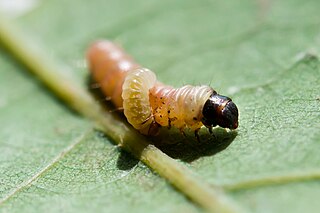
Gyrtona is a genus of moths of the family Euteliidae first described by Francis Walker in 1863.

The Depressariinae – sometimes spelled "Depressiinae" in error – are a subfamily of moths in the superfamily Gelechioidea. Like their relatives therein, their exact relationships are not yet very well resolved. It has been considered part of family Elachistidae sensu lato or included in an expanded Oecophoridae. In modern classifications they are treated as the distinct gelechioid family Depressariidae.
Chrostosoma haematica is a moth of the subfamily Arctiinae. it was described by Maximilian Perty in 1834. It is found in Ecuador and Brazil.

Psilocorsis is a genus of moths of the family Depressariidae.
Psilocorsis propriella is a moth in the family Depressariidae. It was described by Zeller in 1877. It is found in Colombia.
Psilocorsis exagitata is a moth in the family Depressariidae. It was described by Edward Meyrick in 1926. It is found in Colombia.
Garrha absumptella is a moth in the family Oecophoridae; described by Francis Walker in 1864. It can be found in Australia, where it has been recorded from New South Wales and Tasmania.
Chezala carella is a moth in the family Oecophoridae. It was described by Francis Walker in 1864. It is found in Australia, where it has been recorded from Queensland.
Inga incensatella is a moth in the family Oecophoridae. It was described by Francis Walker in 1864. It is found in Venezuela and Guyana.
Machimia sejunctella is a moth in the family Depressariidae. It was described by Francis Walker in 1864. It is found in Brazil.
Psilocorsis amydra is a moth in the family Depressariidae. It was described by Ronald W. Hodges in 1961. It is found in North America, where it has been recorded from Arizona.
Psilocorsis arguta is a moth in the family Depressariidae. It was described by Ronald W. Hodges in 1961. It is found in North America, where it has been recorded from Arizona.
Psilocorsis cirrhoptera is a moth in the family Depressariidae. It was described by Ronald W. Hodges in 1961. It is found in North America, where it has been recorded from Arizona.
Psilocorsis melanophthalma is a moth in the family Depressariidae. It was described by Edward Meyrick in 1928. It is found in Colombia.

Tonica niviferana is a moth in the family Depressariidae. It was described by Francis Walker in 1864. It is found in India, Sri Lanka, northern Vietnam and China.
Tonica terasella is a moth in the family Depressariidae. It was described by Francis Walker in 1864. It is found on Borneo.
Dichomeris contentella is a moth in the family Gelechiidae. It was described by Francis Walker in 1864. It is found on Borneo.
Hypatima deviella is a moth in the family Gelechiidae. It was described by Francis Walker in 1864. It is found in Taiwan, Thailand, the Philippines, Sri Lanka, India, on Borneo, Java and Sulawesi, as well as in Australia (Queensland).
Hypatima sublectella is a moth in the family Gelechiidae. It was described by Francis Walker in 1864. It is found on Borneo.

Gymnobathra is a genus of moths in the family Oecophoridae. It was first described by Edward Meyrick in 1883. All species are found in New Zealand.




